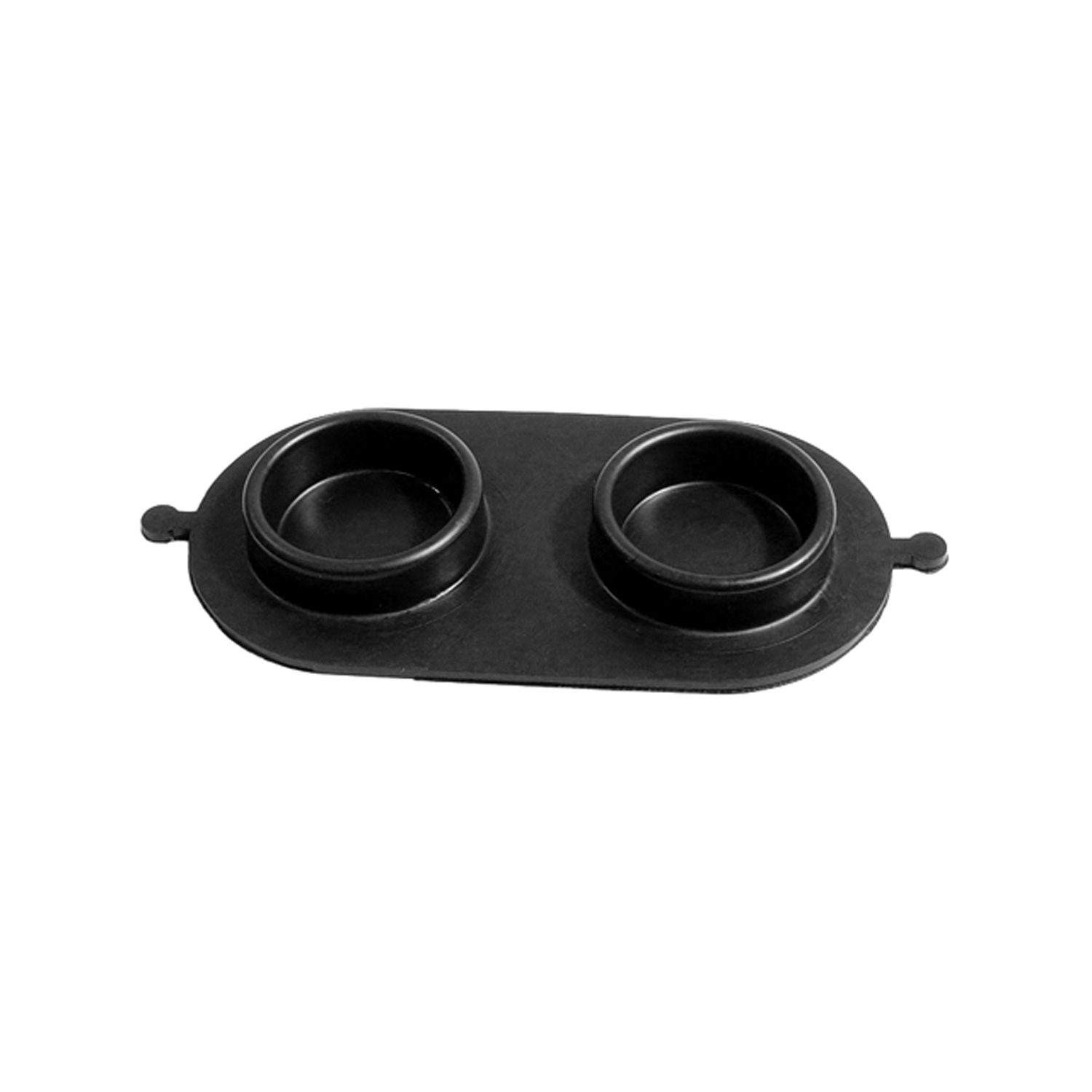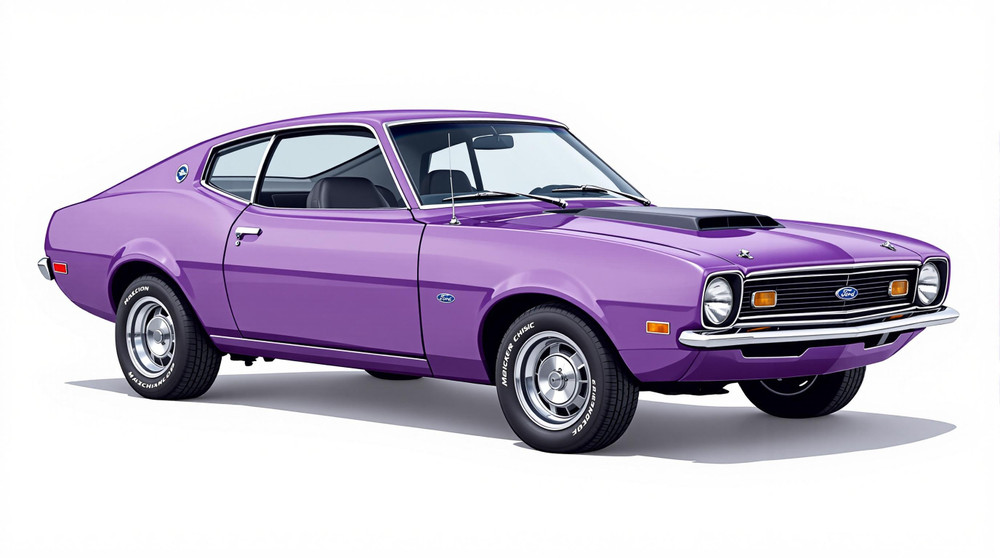Image of 1973 Ford Maverick, Note: These illustrations use artistic license and may differ from actual historical models.
Performance Metrics
Fundamental Metrics
Emotional Appeal
MMP Rating
| Engine Specifications | |
|---|---|
| Engine Options: | 200 CID I6, 250 CID I6, 302 CID V8 |
| Displacement Range: | 200-302 cubic inches |
| Horsepower Range: | 88-140 hp |
| Torque: | 122-239 lb-ft |
| Compression Ratio: | 8.0:1 - 9.0:1 |
| Ignition System: | Conventional, distributor |
| Cooling System: | Liquid-cooled |
| Performance Specifications | |
| 0-60 Time: | Estimated 10-12 seconds |
| 1/4 Mile Time: | Estimated 17-19 seconds |
| Top Speed: | 105-110 mph |
| Transmission and Drive | |
| Drive Type: | Rear-wheel drive |
| Transmission Type: | 3-speed manual, 3-speed automatic |
| Fuel and Efficiency | |
| Fuel System Type: | Carburetor |
| MPG: | Estimated 15-20 mpg |
| Dimensions and Brakes | |
| Brakes: | Front disc, rear drum |
| Wheelbase: | 103.9 inches |
| Weight: | 2,800-3,100 lbs |
Note: Specifications for classic cars are given to the best of our ability, considering the limited and variant data available.
1973 Ford Maverick: The Unsung Hero of American Muscle
The 1973 Ford Maverick may not be the first car that comes to mind when you think of classic American muscle, but it's a vehicle that deserves a closer look. Born in the heyday of the muscle car era, the Maverick was Ford's answer to the growing demand for smaller, more affordable cars. It was a car that offered a blend of economy and performance, wrapped up in a package that was distinctly American.
This compact car made its debut in 1969 as a 1970 model and quickly became a hit due to its low price and simple design. By 1973, the Maverick had established itself as a reliable and economical choice for buyers who wanted a taste of muscle without the hefty price tag. A unique fact about the Maverick is that it was initially marketed using the tagline "The Simple Machine," which highlighted its straightforward design and ease of maintenance.
Design and Innovation: The Maverick's Allure
The exterior styling of the 1973 Ford Maverick was both sporty and functional. With its long hood, short deck proportions, and distinctive grille, it echoed the design language of its larger muscle car siblings. The interior featured a no-frills approach with an emphasis on practicality. Materials were durable, if not luxurious, reflecting the vehicle's economy-class status.
For its time, the Maverick included some noteworthy technological features such as optional power steering and disc brakes, which were not yet standard in all vehicles. Color options ranged from subdued earth tones to vibrant hues like Grabber Blue, with brighter colors often being favored by enthusiasts.
Body styles included a two-door sedan and four-door sedan, with the two-door models being particularly popular among those looking for a sportier appearance. The Grabber trim package added sporty stripes, special graphics, and a spoiler, enhancing the car's appeal.
Historical Significance: The Maverick's Mark on Motoring
The 1973 Ford Maverick played an important role in bridging the gap between economy cars and muscle cars. It offered an accessible entry point for consumers who desired performance but also valued practicality. Its success helped pave the way for future generations of affordable performance-oriented vehicles.
Performance and Handling: A Balanced Ride
Under the hood, the '73 Maverick could be equipped with various engines, including an inline-six for those prioritizing fuel efficiency or a more powerful V8 for those seeking thrills. While not as fast as some of its contemporaries, with top speeds averaging around 100 mph and 0-60 times in the mid-to-high second range depending on engine choice, it provided ample performance for everyday driving.
On the road, drivers appreciated the Maverick's relatively nimble handling for its class—especially when fitted with performance suspension options. The driving experience was characterized by a satisfying rumble from under the hood and a ride that was firm yet comfortable enough for daily commutes or weekend cruising.
Ownership Experience: Living with a Maverick
The 1973 Ford Maverick found its niche as both a daily driver and an occasional show car. Its simplicity meant that maintenance was straightforward for most owners, contributing to its reputation for reliability. Parts were readily available and affordable, making repairs less daunting than some other classic cars.
Fun Facts: The Maverick's Unique Legacy
Despite not being as famous as some other Ford models, Mavericks have their share of interesting trivia. For instance, they occasionally appeared in police fleets during their production years. Criticisms often centered around their basic interiors and lack of refinement compared to more upscale competitors.
Collector's Information: Investing in a Maverick
Today, collectors can find a 1973 Ford Maverick at various price points depending on condition and originality. Estimates suggest that hundreds of thousands were produced during this year alone. As interest in classic cars continues to grow, values for well-maintained Mavericks have been appreciating modestly over time; prices can range from $5,000 for models in fair condition to upwards of $20,000 or more for pristine examples or those with desirable options like the V8 engine or Grabber package.
Conclusion: Celebrating an Understated Classic
The 1973 Ford Maverick may not have been designed to set records or turn heads like some of its peers did so effortlessly. However, its blend of practicality and performance ensured it would leave an indelible mark on automotive history—a mark that continues to resonate with enthusiasts today who appreciate this unsung hero of American muscle.
1973 Ford Maverick Catalog of Parts
 1973 Ford Maverick Brake Master Cylinder Cover Seal. Replaces OEM #C7AZ2167-A-RP 2-BBrake Master Cylinder Cover Seal. Replaces OEM #C7AZ2167-A. Each
1973 Ford Maverick Brake Master Cylinder Cover Seal. Replaces OEM #C7AZ2167-A-RP 2-BBrake Master Cylinder Cover Seal. Replaces OEM #C7AZ2167-A. Each 1973 Ford Maverick Windshield and Rear Windshield Reveal Molding Clip-WF 226Windshield and Rear Windshield Reveal Molding Clip. Made of steel. Each
1973 Ford Maverick Windshield and Rear Windshield Reveal Molding Clip-WF 226Windshield and Rear Windshield Reveal Molding Clip. Made of steel. EachWhy Choose Metro?
For over 100 years, Metro Moulded Parts has been the pinnacle of quality in classic car restoration parts. Our commitment to precision and authenticity in every component ensures a perfect fit and an OEM-level appearance.
- Expert Craftsmanship & Quality: Each part is a testament to our dedication to reliability and perfection, crafted from original designs and thoroughly tested.
- Advanced Technology: We use cutting-edge techniques to create flawless, long-lasting parts that surpass others in performance.
- SuperSoft Sponge – The Ultimate Door Seal: Not only are our door seals 30% softer than competitors', but they're also guaranteed to never leak. They effectively reduce wind and road noise, enhancing your classic car's comfort and driving experience.
- Proudly American: Our parts are a product of American craftsmanship, made in the USA with a spirit of excellence and heritage.
- Unrivaled Warranty: We back our products with a 30-year industry-leading warranty, a testament to our confidence in their quality.
Join us in preserving the legacy of classic cars with parts that are crafted for perfection, not just made.

